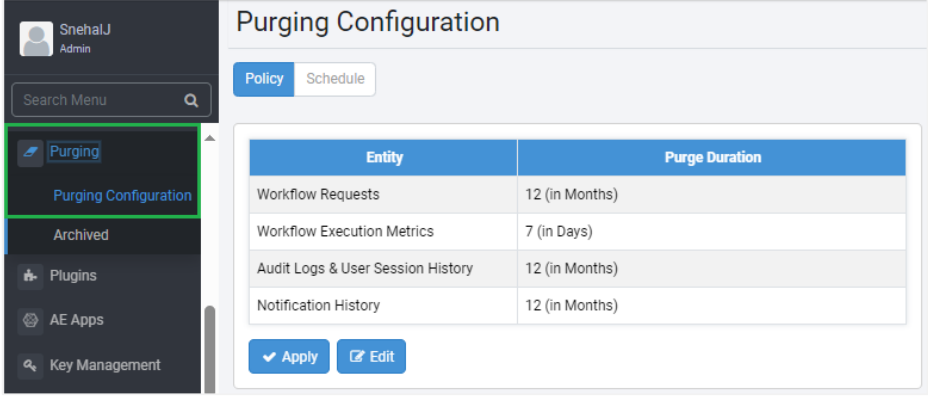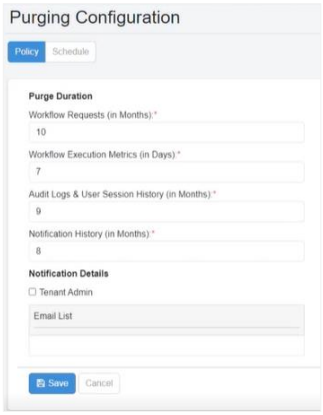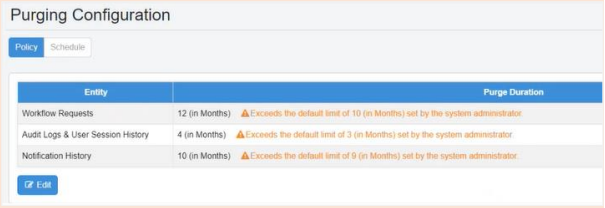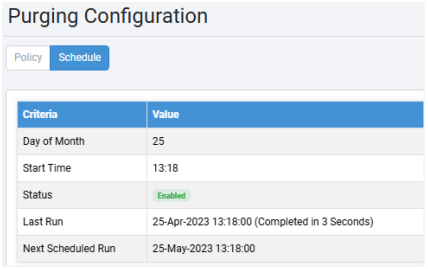Modify Purge Policy
In the topic you will learn about how to configure the purge policy and schedule the purge. As an Admin, you can either apply or edit the purge policy details. The purge policy determines Purge Duration (in months) for each table data for Audit Logs, User Session History, Workflow Requests, and Notification History. For Workflow Execution Metrics data, the purge duration is in days.
The Workflow Execution Metrics purge details is available if the Workflow Metrics service is running.
The purged data is then available as archives.
There are two scenarios for the application of the purge policy:
Scenario 1: If the flag, ae.global.purge.enabled=false, in the ae.properties file, then:
-
You can apply purging only for those tenants who have specified a purge policy.
-
The Purge Duration set by the System Administrator and Admin are considered, and the policy which has lesser purge duration is applied to the tenant. For example, see the following screenshot:

Scenario 2: If the flag, ae.global.purge.enabled=true, in the ae.properties file, then:
- You can apply the purging policy globally to all tenants irrespective of whether the tenant has defined a purge policy or not. If the tenants do not have a purge policy, then the System Administrator’s policy is applied to all tenants.
- If tenants have purged policy, then Purge Duration set by the System Administrator and Admin are considered, and the policy which has lesser purge duration is applied to all tenants.
The Purging Configuration page has the following two tabs:
- Policy: Apply or edit purge policy
- View notification details
- Schedule: View a purge schedule
Policy: Apply or edit purge policy
Apply or edit the purge policy configured by the System Administrator and define the purge duration and notification details.
To apply or edit a purge policy:
-
In the menu, click Purging → Purging Configuration. The Purging Configuration page appears.
 Note:
Note:Apply is unavailable, if ae.global.purge.enabled=true, in the ae.properties file.
-
To apply the purge policy, click Apply. Application of the tenant policy is a one-time activity. OR To edit the tenant policy, click Edit.

-
In the edit page, enter the following details:
Field name Description Purge Duration Workflow Requests (in Months)* Enter the data retention duration in months for the workflow requests. The records older than the set duration are purged from the data table.
For example, if you set 12 months, then any record older than 12 months will be permanently deleted from the data table when the scheduled purge job runs.Workflow Execution Metrics (in Days)* Enter the data retention duration in days for the workflow execution metrics. The records older than the set duration are purged from the data table.
For example, if you set 7 days, then any records older than 7 days will be permanently deleted from the data table when the scheduled purge job runs.
Note: The Workflow Execution Metrics (in Days) field is available only if the Workflow Metrics service is running.Audit Logs & User Session History (in Months)* Enter the data retention duration in months for audit logs and user session history. The records older than the set duration are purged from the data table.
For example, if you set 12 months, then any records older than 12 months will be permanently deleted from the data table when the scheduled purge job runs.Notification History (in Months)* Enter the data retention duration in months for notification history. The records older than the set duration are purged from the data table.
For example, if you set 12 months, then any records older than 12 months will be permanently deleted from the data table when the scheduled purge job runs.
Notes: The value for Notification History must be less or equal to the value entered for Workflow Request.Notification Details Tenant Admin Select the checkbox to add the list of emails to whom you want send notification emails. Email List Enter the email addresses of users you want to send the emails to. *Indicates mandatory field.
Note:You can set the purge duration of the policy equal to or less than the duration set by the System Administrator. Else, you’ll see the following:

The purge policy is applied depending on the purge duration set by the System Administrator or Admin. If you set the purge duration less than that set by the System Administrator, then the Admin’s purge policy is applied to the tenant.
-
Click Save. The purge details are saved.
Notification details
System Administrators or Admins may send notifications if SMTP configuration is completed.
System Administrator sends emails to all the Administrator’s in the following cases:
- If the Tenant overwrites the purging policy, then the Admin sends email from the configured SMTP for the Tenant to all Admins in the Tenant organization and the emails listed for notifying. The following events result in sending notifications:
- Sysadmin creates/updates Purge Policy
- Sysadmin creates/updates/deletes Purge Schedule
- Admin updates Purge Policy, specific to the Tenant. AutomationEdge sends an email to Admins in the Tenant and Users emails listed for notifying.
- Three days before the purging schedule, a notification is sent every day to all Tenants Administrators and user emails listed for notifying.
- The number of days is configurable such as seven days etc. The number of days is configurable in the AutomationEdge properties file. Set ae.purge.notification.period=<number of days, for example, 7>.
- Notification after purging completion is for all Tenants.
Understand how purging works
- When the scheduled purge starts for the tenant, the data tables are purged in the following order:
- Notification History
- Audit Logs
- User Session History
- Workflow Execution Metrics – available if you have configured the following property in the ae.properties file:
ae.workflow.monitoring.enabled = true property. - Workflow Requests
- The purging happens in batches of 10,000 records, that is, if there are 50,000 records in the Audit Logs data table then the records will be permanently deleted in 5 batches, with each batch containing 10,000 records.
- When the purging of the parent data table is in progress then the purging of records of any child or dependent data table also happens in the same purge operation.
For example, when purging of records of Workflow Requests data table is in progress then purging of records of the following dependent or child data tables also happens in the same purge schedule:
- Human In Loop Task Data Mappings
- Human In Loop Task User Mappings
- Human In Loop Task Group Mappings
- Human In Loop Tasks
- DocEdge Consumption Data
View a purge schedule
You can create a purge schedule. Several options and flexibility in setting up the purge schedule have been provided based on:
- Day of a month
- Day of a week (First, Second, Third, Fourth or Last)
- The Purge schedule executes a minimum after seven days from the current date.
- The first execution of the Schedule will happen from the next month if the days between now and the next trigger is less than or equal to Seven days for the current month.
- If the server is down on the day the schedule is to be triggered, then the schedule executes the next day at the same time.
To view a purge schedule:
-
In the menu, click Purging → Purging Configuration. The Purging Configuration page appears.
-
On the Purging Configuration page, click the Schedule tab. The purge schedule page appears.

-
View the schedule details:
Field name Description Criteria Day of Month
Or
Day of WeekDisplays the day of the month when the purge is scheduled. For example, 5 indicates 5th day of the month.
Or
Displays the day of the week when the purge is scheduled. For example, Saturday.Week of the month Displays the week of the month in which the purge is scheduled. For example, 4.
Note: The field is displayed only if the selected criteria is Day of Week.Start Time Displays the time when the scheduled purging will start. Status Toggle the switch to enable or disable the schedule. Last Run Displays when the previous scheduled purge was run. Next Scheduled Run Displays the date and time when the next scheduled purge will run.